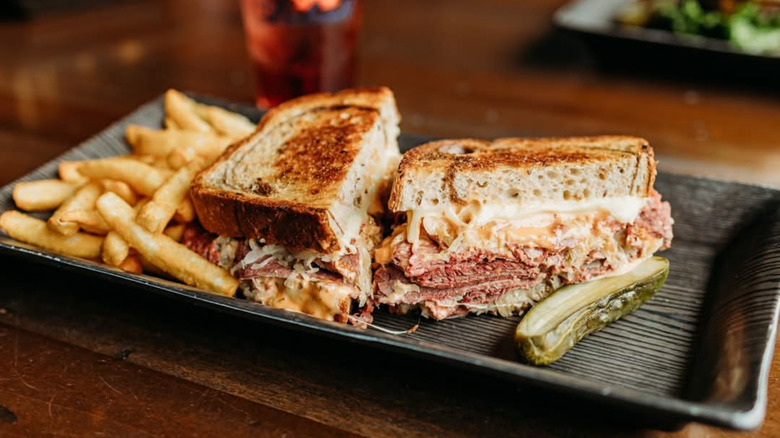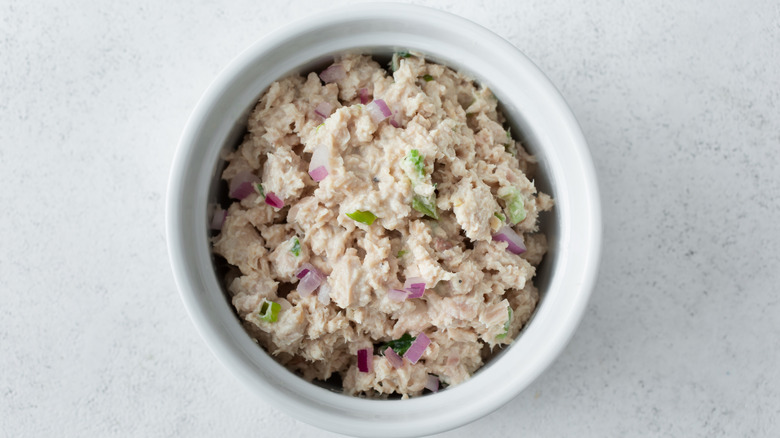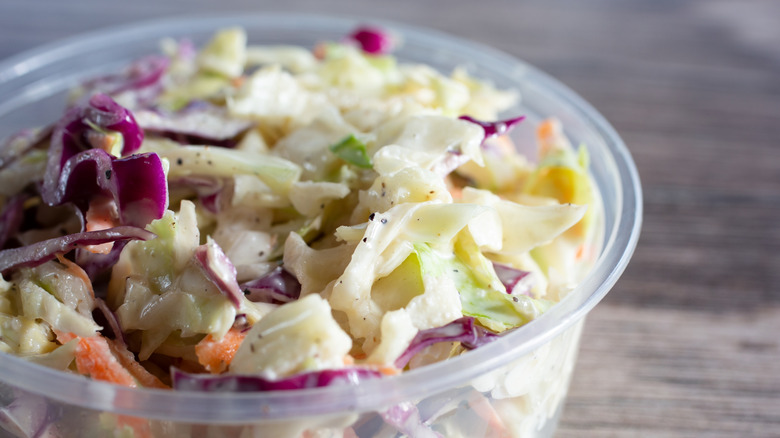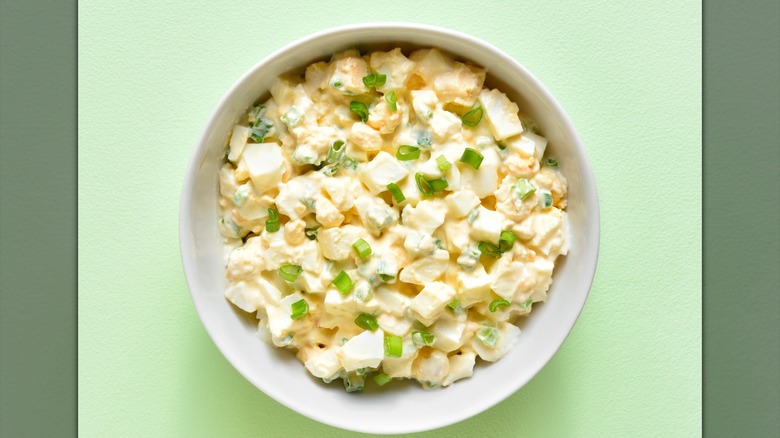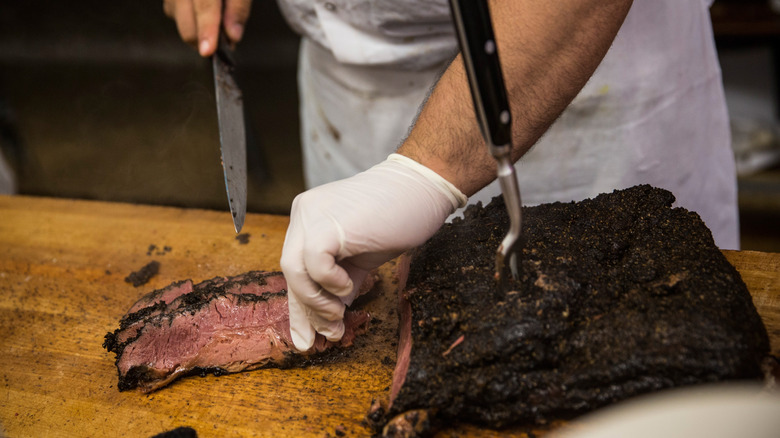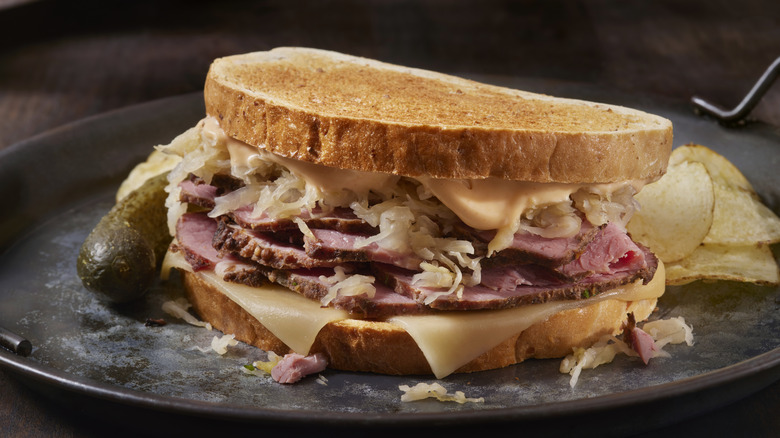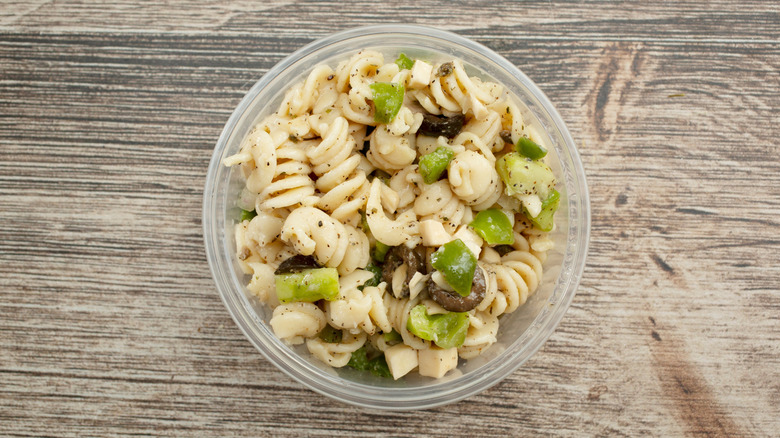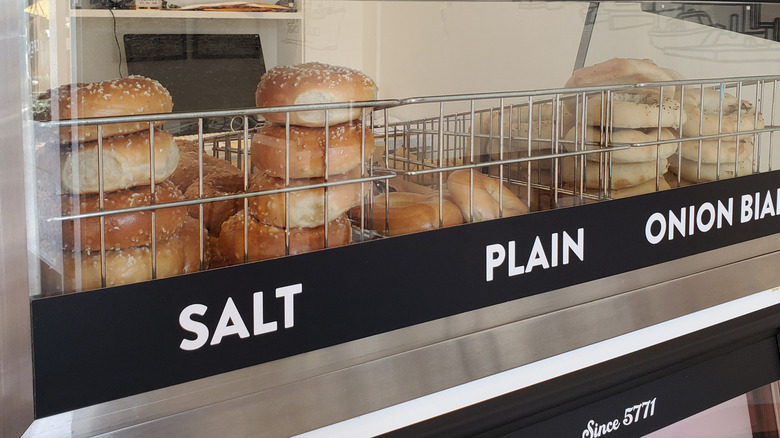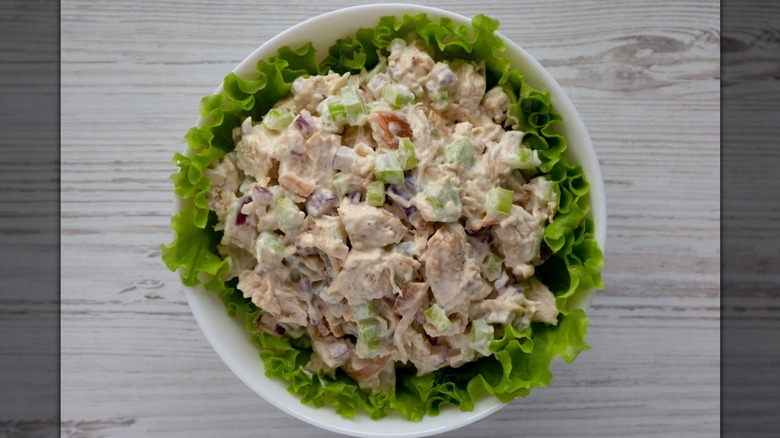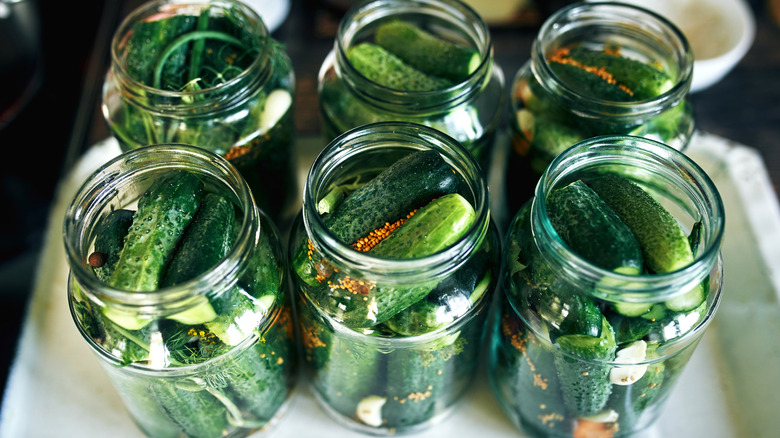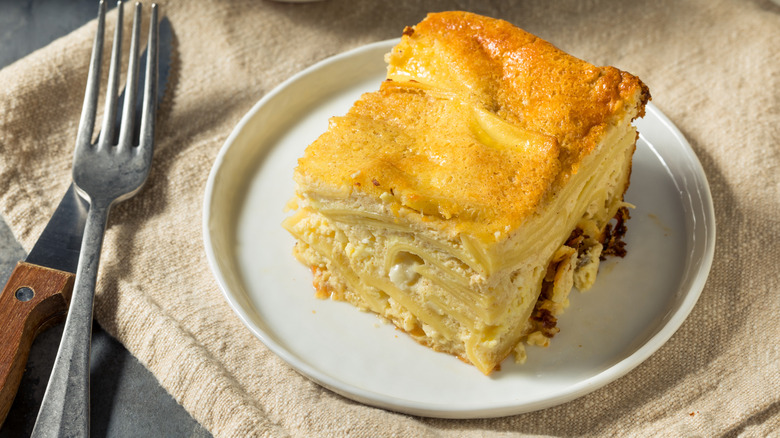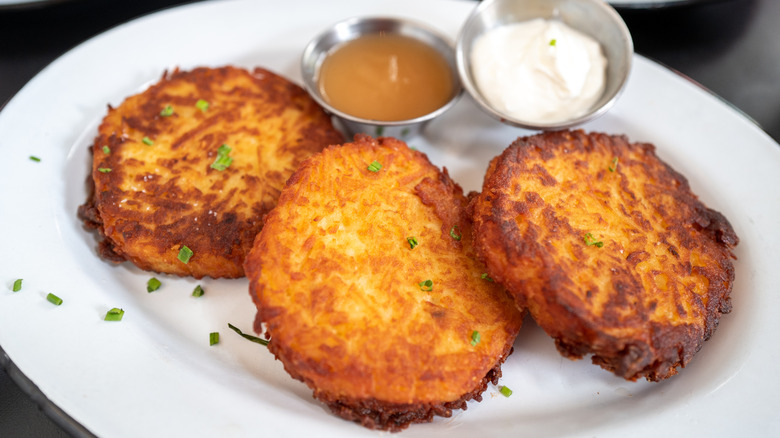11 Deli Counter Classics That Always Taste Better Than Homemade
We've all been there — scrambling to make egg salad only to end up with, well, egg on our face. Or staring at coleslaw that's turned into a cabbage-flavored swamp. Sometimes, our homemade dishes just aren't a hit. Meanwhile, the local deli consistently gets it done. Perfect pasta salad. Poached-to-perfection chicken salad. Pastrami with a pickle on the side. The deli makes masterpieces. In comparison, our homemade attempts sometimes turn out a little lackluster.
Maybe it's access to the best ingredients. Maybe it's the industrial equipment. Maybe it's the line cooks who can chiffonade lettuce in their sleep. Maybe it's just that someone else is making it. Whatever it is, there's no shame in admitting that some dishes just taste better from the deli. From potato pancakes to seemingly simple tuna to bagels whose chewiness defies physics, let's peek behind that glass case and admire some deli classics that always taste better than homemade.
1. Tuna salad
Why does tuna salad taste different from the deli? It seems like it should be simple — just pop open a can and mix a few ingredients together. But that approach usually falls short. One key step often missed at home — let it chill. Giving it a bit of fridge time allows the flavors to mingle and meld. Even when delis make a hot tuna melt, they're likely starting with chilled tuna salad.
Now, let's talk mayo — it should be good and there should be plenty of it. For Jewish deli-style tuna salad, Hellmann's is a classic. In fact, it was Julia Child's mayo of choice when she made her own tuna sandwiches (and if it's good enough for Child, it's probably good enough for the rest of us). But don't feel locked in — exploring other mayonnaises or even whipping up your own can elevate your tuna salad. Take it from Nielsen's Delicatessen, Houston's oldest deli, which uses a housemade mayo as the base for its tuna salad. The folks behind the counter readily admit that the mayo is the secret weapon.
Another deli secret — breadcrumbs, such as a spoonful of panko. Flaky panko breadcrumbs are typically used for a crispy fry coating, but in a tuna salad, they soak up flavor and add a light, almost fluffy texture that's moist but not watery. Many delis slip panko or other breadcrumbs into their tuna salad — definitely a trick worth borrowing for your own kitchen experiments.
2. Coleslaw
You know that satisfying crunch you get when you bite into deli coleslaw? That's the gold standard — crisp cabbage, even when it's swimming in dressing. But when it comes to homemade coleslaw? Well ... it often starts strong in the flavor department, but by the time it hits the potluck table, it's wilted and sitting in a sad little puddle. The culprit? Salt. Yep, the very thing that makes your dressing delicious is also sneakily pulling water out of the cabbage, diluting your hard work and turning your slaw into a veggie swamp.
How do you prevent watery coleslaw? Salt your cabbage before it even thinks about mingling with the rest of the ingredients. Just toss a head of prepared cabbage with about a tablespoon of kosher salt. Let it sit in a colander for an hour or two — preferably over the sink or a bowl, unless you fancy a cabbage-scented kitchen counter. The salt will work its magic to pull excess moisture out of the cabbage.
Once time's up, give the cabbage a good rinse with cold water to wash away the saltiness, then pat it dry with paper towels, a clean dish towel, or take it for a spin in a salad spinner. What you're left with is cabbage that's not just dry, but confident and ready for your favorite coleslaw recipe. No more watery disasters. Just crunchy, creamy slaw that holds its own at any BBQ, potluck, or weeknight dinner. Honestly? The deli might get jealous.
3. Egg salad
Classic deli-style egg salad tends to be straightforward — chopped hard-boiled eggs seasoned with mayonnaise, Dijon mustard, salt, and pepper. Sounds simple enough, right? And yet ... the deli version always seems to taste better.
Here's the yolk of the matter — it's all about the eggs. Delis have egg boiling down to a science, or they've got a stash of pre-boiled perfection. They know just how to treat those eggs to get tender whites and yolks that are firm but never chalky. With the main ingredient done just right, the texture and flavor of the egg salad will be perfect.
At home, it's easy to overcook hard-boiled eggs. Even 30 extra seconds and your eggs go from promising to rubbery whites and dry, crumbly yolks. And while there are a lot of tips for making perfect hard-boiled eggs, the advice can be as mixed as ... well, egg salad. Drop them in boiling water, start them in cold water — every chef and their grandmother has an opinion. And experts can rattle off times, but it will vary depending on the size of your eggs, the number of eggs in the pot, the volume of water, the egg's starting temperature, and possibly the phase of the moon. Cooking the perfect hard-boiled egg is part art, part science, and maybe a little bit of astrology. But once you crack the code, your homemade egg salad can absolutely rival the deli experts.
4. Deli meat
Making your own deli meat sounds like a fun project — and it can be! But despite all the brining, rubbing, smoking, and homemade love that goes into it, it's tough to recreate that deli experience. Home chefs just don't have access to the same specialty cuts and industrial equipment to make deli meat.
Take pastrami, for example. Legendary spots like Katz's Delicatessen in New York City don't just toss some meat in the oven and call it a day — Katz's goes full culinary marathon. First, the meat soaks in a saltwater brine spiked with spices — for weeks. After its long soak, each slab gets a spice rub-down, then spends hours in custom-built smokers. The smoked meat then goes into boiling water to tenderize and wash off any extra salt. Finally, it's held in steam tables, where it waits to be sliced by a master carver. Katz's has been fine-tuning this process since 1888. That's a whole lot of practice.
While not all delis go through this marathon, even the less hands-on spots start with top-notch cuts like the navel — a tough piece of beef that turns into tender pastrami. But many of these premium cuts are reserved for wholesale, making them hard for home chefs to find. So, if your homemade meat doesn't taste quite like New York's finest, don't be too hard on yourself — you're up against centuries of tradition, a ton of specialized equipment, and cuts of meat that typically don't make it to the supermarket.
5. Sandwiches
You can march home with half a pound of top-shelf pastrami and a heart full of hope, yet your DIY sandwich still isn't as good as the deli's sandwich. Obviously, the type of bread matters when making a sandwich. Delis have bread hookups — artisan bakeries on speed-dial or in-house bakers. They also know what bread goes well with what sandwich — rye is destiny for a Reuben, and something like sourdough can handle wet tuna.
Then come the condiments and toppings. They don't just slap some mayo on a slice of bread and call it a day — they spread all over, on both slices and the meat. It's not about more mayo, it's strategic mayo. And it might be their own house-whipped aioli or a mysterious deli dust they'll never admit contains paprika, fairy wishes, and a legally dubious amount of umami.
While you're at home rummaging for that last wilted lettuce leaf, wondering if slightly translucent is still safe, the deli has a crisper the size of a studio apartment. They might even season the veggies for extra flavor, such as a little sea salt on lettuce and tomatoes. Combine that with luxury spreads and perfect bread, it's no wonder your kitchen counter can't compete.
6. Pasta salad
Good delis turn a humble curl of pasta into something you want by the pound. Why does deli pasta salad taste better than homemade? Part of the reason is simple — quality ingredients. But that doesn't mean rushing out to buy fresh pasta. It might seem like the fresher, the better, but fresh pasta tends to get a little sad and soggy. Dried pasta is a better choice to hold up to refrigeration, dressings, and mix-ins. And when you're looking for a winning dried pasta, go for the bronze — bronze-cut, that is. This traditional method, unlike the newer and cheaper Teflon-cut pastas, creates a rougher surface. Teflon pasta is like a slip 'n slide for sauces — everything just slides right off. But the porous surface of bronze-cut pasta lets sauces seep deep into every noodle, creating a flavor-packed bite.
Shape also matters. Opt for corkscrew-shaped pastas, like cavatappi, fusilli, or rotini. These act like tiny spiral-shaped sauce traps. Or embrace the charm of bow tie pasta. Bow ties aren't just cute — they're also full of little nooks and crannies to capture the dressing for an integrated flavor.
Finally, if you want your pasta salad to taste more like the deli version, plan ahead. Flavor magic doesn't need a wand — it just needs time. Make your pasta in advance so it can marinate overnight in the fridge. It really will taste better the next day. Keep a little dressing on hand, just in case you need to moisten the dish before serving.
7. Bagels
With enough time and a little stubbornness, you can make bagels at home. And they'll be delicious — maybe a bit misshapen, but full of love. As for deli bagels? The truly great ones usually come from experts who know the bagel-making process like the back of their flour-dusted hands. Crafting a great bagel is a time-intensive process involving ingredient selection, mixing, fermenting, shaping, proofing, boiling, topping, baking, cooling ... are we eating yet?
Preparing the dough starts with the right flour. For that classic chew, you need high-gluten flour. Bread flour is an OK backup, but skip the all-purpose unless you're going for a soft, sad bread ring. After mixing and fermenting, it's time for shaping. Getting a uniform ring takes practice. In New York City, there's even a small army of freelance bagel rollers — respected artisans who work for multiple delis and bagel shops. Some places opt for shaping machines. Most of us, of course, don't have access to shiny bagel robots in our home kitchens.
Then there's the cooking. Traditionalists boil their bagels before baking, which contributes to a chewy crust. Others skip boiling and steam their bagels instead — those tend to be fluffier and, some might argue, less satisfying. When it's finally time to bake, commercial ovens crank the temperature up to 500 degrees Fahrenheit, often using rotating shelves that keep the bagels moving for even baking. It's a level of bagel perfection that's hard for a home oven to match.
8. Chicken salad
Chicken salad is as decisive as the chicken or the egg debate. Mayonnaise or Miracle Whip? Maybe Greek yogurt instead? Is it nuts to add grapes? Are you grateful for nuts? What about the chicken itself?
Rotisserie chicken is a go-to shortcut at home — it's flavorful and already done. But that convenience can bite back. It's sometimes too salty, or has that mystery dryness with the occasional piece that chews like packing foam. A slightly more laborious but worth-the-effort approach is poaching chicken breasts. They stay super moist, so every bite of your chicken salad will be uniformly tender. Plus, you control the salt. You can also season the poaching liquid with onion, bay leaf, lemon peel, or peppercorns to infuse the meat with flavors to complement your choice of mix-ins.
Many of the best deli chicken salads owe their flavor to this method. Kenny & Ziggy's Delicatessen in Houston, which proudly makes the list of best delis in the United States, admits that the secret to its delicious chicken salad is simple — poached chicken breast, Hellmann's mayo, celery, onion, salt, and pepper. Just quality ingredients and a very good poaching pot. And it's not just high-profile spots doing it this way. Gourmet Boutique supplies delis nationwide with its Homestyle Chicken Salad, made with — you guessed it — poached chicken breast, mayo, and celery. Whether you find it in grab-n-go containers or big bowls behind the counter, it's proof that good chicken salad doesn't have to be homemade.
9. Pickles
Few things are more satisfying than the snap of a good deli pickle. Unlike vinegar-based pickles, half sours and full sours are deli classics made through lacto-fermentation — a fancy term for letting cucumbers hang out in a salty brine. Half sours are bright green, crisp, and tangy. Full sours take their time, fermenting for weeks until they develop a more intense flavor and a slightly less photogenic shade of green.
When looking for a fun weekend DIY project, it's easy to think, "It's just water, salt, and cucumbers. How hard can it be?" But here's where many pickle enthusiasts get themselves into, well, a pickle. Tap water usually has chlorine in it, which will mess with the fermentation process. Use distilled water. And choose salt wisely. Iodized salt also messes with the magic of fermentation. Stick to kosher, pickling, or fine sea salt — and don't hold back. Home recipes often skimp on salt, but deli brine is plenty salty (think a robust 5%). Finally, the cucumbers — get them fresh! Farmers-market-this-morning fresh. Small kirby or pickling cucumbers are ideal.
Even if you nail the three basic ingredients, many delis add a medley of spices — dill seed, garlic, mustard seed, peppercorns, coriander, cloves, allspice, maybe even cinnamon. Whether a deli house-brines their own pickles or sources them from elsewhere, that delicious and tangy crunch often comes from a secret recipe or proprietary spice blend. Matching that good deli pickle at home will be a bit of a guessing game.
10. Noodle kugel
Noodle kugel is a classic star of the deli counter — versatile, beloved, and always a hit. Often likened to bread pudding or rice pudding, kugel swaps out bread or rice for noodles. While many of us cook up delicious noodle kugels at home, some deli versions have that special something that leaves our homemade attempts tasting a bit like understudies.
Zingerman's Delicatessen in Ann Arbor is generous enough to publish its recipe, so we can all find out why our kugel sometimes falls short. First twist — instead of cottage cheese or cream cheese, Zingerman's uses farm cheese. That adds bright, tart notes that might be missing from many homemade versions. Next, Zingerman's ditches vanilla extract to scrape an actual vanilla bean, adding even more intense flavor than the vanilla extract so many home recipes rely on. And when those homemade recipes call for raisins, they don't always specify what type of raisins, leaving us to our lackluster, pantry-dwelling varieties. Meanwhile, Zingerman's chooses Red Flame raisins — an extra sweet variety that adds tasty bursts of fruit with every bite.
Add it all up and you get a kugel that's sweet, custardy, lightly tart, and all around delicious. Sure, you can bake a fine version at home — but when a deli treats each ingredient like a VIP, the result isn't just kugel, it's a star-studded event.
11. Potato pancakes (latkes)
Potato pancakes, aka latkes, sound disarmingly simple: grated potatoes and onions held together by an egg and a sprinkle of matzo meal or breadcrumbs. At home, you slide spoonfuls into a skillet, pray they stay in one piece, and try not to taste-test half the batch before dinner. A quick flip later, you're rewarded with a golden crust and a fluffy middle — especially tasty topped with applesauce, sour cream, or, if you're feeling fancy, a dollop of both.
But here's the crispy truth — your neighborhood deli might have a secret weapon you probably don't — a fryer that keeps oil at the perfect temperature so every latke hits the plate shatter-crisp on the outside, creamy on the inside, and identical to the one before it. Even delis that stick to stovetop pan-frying have a leg up — a line cook who's flipped more latkes than most of us have flipped calendar pages. At home, you're juggling overcrowded skillets, a temperamental burner, and the urge to nudge each pancake "just to check." One degree too hot and you've got charcoal-latke, a tad too cool and you're serving soggy lumps.
Sure, you can jazz up latkes in your own kitchen — swap russets for sweet potatoes, fold in herbs or beets, maybe add some pesto for good luck. But when you crave that classic potato latke with a textbook crunch and comfortingly-soft center, let the deli do the heavy lifting — and keep your stovetop blissfully splatter-free.
